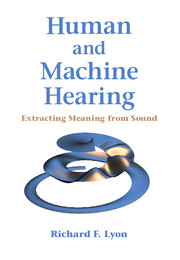Book contents
- Frontmatter
- Dedication
- Contents
- Foreword
- Preface
- Part I Sound Analysis and Representation Overview
- Part II Systems Theory for Hearing
- 6 Introduction to Linear Systems
- 7 Discrete-Time and Digital Systems
- 8 Resonators
- 9 Gammatone and Related Filters
- 10 Nonlinear Systems
- 11 Automatic Gain Control
- 12 Waves in Distributed Systems
- Part III The Auditory Periphery
- Part IV The Auditory Nervous System
- Part V Learning and Applications
- Bibliography
- Author Index
- Subject Index
- Plate section
6 - Introduction to Linear Systems
from Part II - Systems Theory for Hearing
Published online by Cambridge University Press: 28 April 2017
- Frontmatter
- Dedication
- Contents
- Foreword
- Preface
- Part I Sound Analysis and Representation Overview
- Part II Systems Theory for Hearing
- 6 Introduction to Linear Systems
- 7 Discrete-Time and Digital Systems
- 8 Resonators
- 9 Gammatone and Related Filters
- 10 Nonlinear Systems
- 11 Automatic Gain Control
- 12 Waves in Distributed Systems
- Part III The Auditory Periphery
- Part IV The Auditory Nervous System
- Part V Learning and Applications
- Bibliography
- Author Index
- Subject Index
- Plate section
Summary
The fact that representation of waveforms as a sum of sine waves is useful in the elucidation of human hearing indicates that something involved in hearing is linear or nearly linear.
—“The nature of musical sound,” John R. Pierce (1999)A basic understanding of linear systems is fundamental to understanding the nature of sound and hearing, including sound sources such as speech and music, sound propagation and mixing, and sound analysis in the inner ear. An understanding of linear systems is also a base on which to build an understanding of important nonlinear aspects of hearing.
In this chapter, we attempt to bring the novice and the expert to a common level of shared understanding about linear systems. The terminology and understanding developed here will support the material in subsequent chapters.
The concepts that we discuss include filters, circuits, impulse responses, frequency responses, convolution, transfer functions (including magnitude, phase, and delay), poles and zeros, transforms, time and frequency domains, eigenfunctions, sinusoids, and complex exponentials. The typical electrical engineering undergraduate education covers all these concepts, but too often some of the important connections between them are neglected. The typical bioengineering or hearing science education may only touch on half of the concepts, sometimes omitting Laplace and Z transforms and the important concept of poles and zeros that we need for our cochlear models. Depending on the level at which one wants to work in human or machine hearing, a deeper understanding of this area can be very helpful.
Linear systems are often encountered in the study of electrical, mechanical, acoustic, and even quantum systems, as well as in the processing of nonphysical data sequences such as stock prices. In a modern engineering or computer science curriculum, linear systems will likely be taught using discrete-time data sequences, processed by digital filters in computer programs. A more traditional approach, at least in electrical engineering (EE), is to teach linear systems using electrical circuits. This approach connects more directly with the continuous-time nature of sound waves and sound processing in the mechanical structures of the ear, so that's where we start.
- Type
- Chapter
- Information
- Human and Machine HearingExtracting Meaning from Sound, pp. 97 - 125Publisher: Cambridge University PressPrint publication year: 2017



